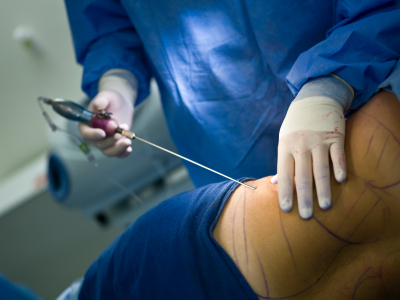One of the most common types of cosmetic surgery, Liposuction (also referred to as lipoplasty, liposculpture, or lipo) is a minimally invasive procedure designed to permanently remove unwanted and persistent fat deposits from a number of places on the body, in order to produce a healthier, more contoured look. While the midsection, thighs, and buttocks are the most commonly targeted sites for fat removal, liposuction treatments are extremely versatile, and can be successfully performed on almost any part of the body where adipose (fat) tissue collects: the neck, the back, the upper arms, the chin, the chest, and so on. You can even get liposuction on your knees!
The main reason for liposuction’s versatility is its surgical simplicity. The simplest procedure (sometimes called suction-assisted liposuction, or SAL) involves the use of a hollow tube called a cannula, along with a suction device known as an aspirator. The cosmetic surgeon works these tools inside of small incisions (usually about a quarter of an inch in diameter) in order to break up and dislodge the targeted deposits of fat, the goal being to remove the desired amount of tissue while causing as little disruption to the rest of the body as possible. All liposuction procedures are alike in these basic ways, but there can be some variation in approach, especially with regards to the type of cannula required:
Power-Assisted – The simplest type of enhancement, power-assisted liposuction (PAL) features the use of a motorized cannula, specially designed to reduce the amount of manual maneuvers required by the surgeon. In all other aspects it is the same as SAL.
Ultrasound-Assisted – Ultrasound-assisted liposuction (UAL) employs a specialized cannula of a different sort, designed to transmit ultrasound. The vibrations that are created help to dislodge and liquefy fat cells, making their suctioned removal much easier. External ultrasound-assisted liposuction (XUAL) is also available, making use of externally applied ultrasound in order to avoid the special cannula, and reduce the potential for tissue disruption and patient discomfort that come with the internal vibrations.
Water-Assisted – Water-assisted liposuction makes use of a cannula designed to emit a continuous jet of water, which, not unlike ultrasound, helps to loosen any fatty deposits for removal. The water also helps to ensure proper drainage, and mitigate post-surgical bruising and edema.
The length of individual liposuction surgeries will vary depending upon the selected procedure type and the extent of the operation. Many patients choose to combine liposuction procedures with other cosmetic surgeries (such as a tummy tuck or lower body lift) in order to save time, consolidate recovery, and to avoid any unnecessary doses of anesthesia. Full recovery from liposuction will generally take a few weeks, during which time the patient may be required to wear a compression garment under his or her clothes – in order to ensure proper healing.
Liposuction is an amazing cosmetic procedure that can achieve some equally amazing results, but it is important to remember that no surgery should ever be considered as a substitute for regular exercise and a healthy lifestyle. In fact, some of the best candidates for liposuction are those physically fit individuals who have a few persistent deposits that remain, despite of diet and targeted exercise.
For more information on liposuction or cosmetic surgery in general, or to get in touch with the top cosmetic surgeons in your area, call 1-800-IDEAL-YOU.

